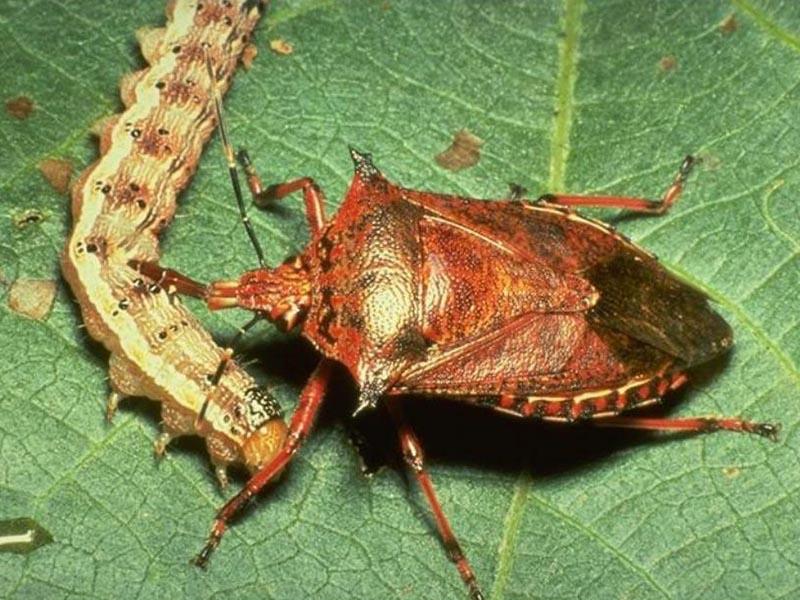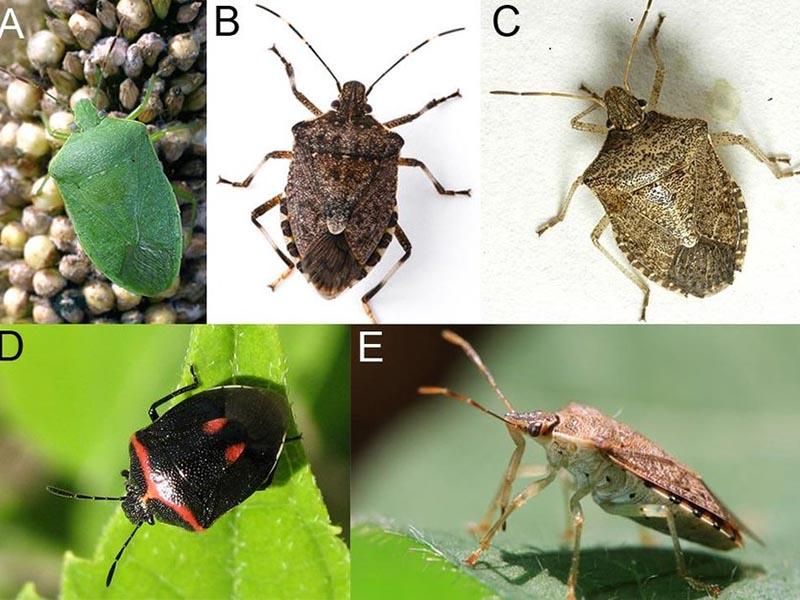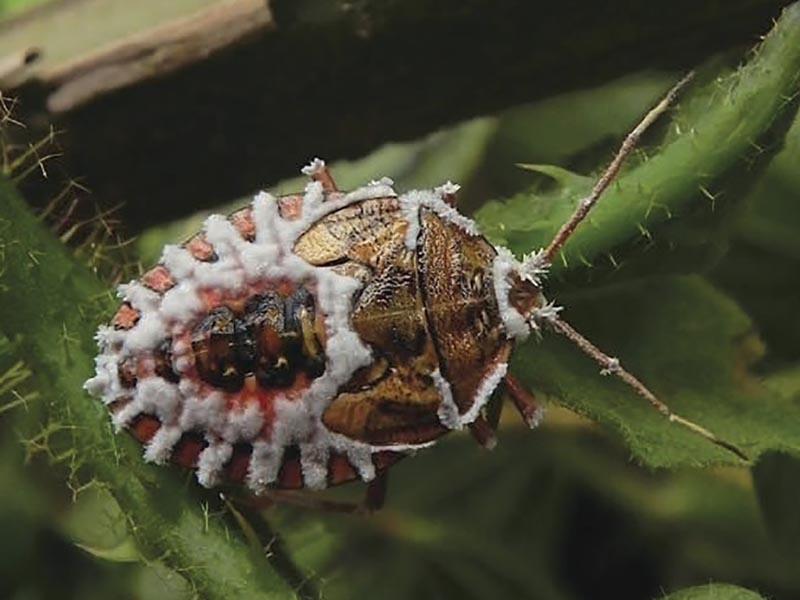
Considering that I have not seen any adult pests - berry scutes, they hide quite well, but still undermine plantings. Rapid death of old shrubs with quality feeding is a sign of the appearance of a large number of insects. Now my questions: how and where to find the offspring of the bedbug, whether the "young" causes the same damage as the adults. I want to destroy the offspring, then there won't be as much damage. Help, please.
The author of the portal answers the question:
In my material below, you will learn about simple ways to control berry pinchers in your own garden.
Shield bugs - what are these bugs. Which class do they belong to?
That's what they call insectsThe body is pentagonal, resembling knight's scutellum. It is a common feature that unites representatives of the family of true shield-feeders. Thanks to it, it makes it possible to recognize insects among many garden and garden pests.
They live in their natural habitat and do not attack humans, because the food source for them is plants.
But they are not beetles, although they are somewhat similar.
| Unit | Semi-hardwings |
| Suborder | Bedbugs |
| Infra Detachment | Pentatomomorpha |
| Superfamily | Shields |
| Family | Real Shieldmen |

A brief characteristic of the genera of the family True Shields (lat. Pentatomidae)
The insects live in a variety of habitats, but prefer moderate, warm microclimates.
They are attracted to fields, orchards, and vegetable gardens, where they can find sources of food.
The family Real Shieldwings is distinguished by species diversity. Among the varieties there are representatives of different colors, body length is also different.

What do shieldflies look like. What colors are representatives of the species. Description. Close-up photos
There are a large number of species of such insects. Common characteristics:
- 3 pairs of limbs;
- 1 pair of antennae (there are 5 segments on each);
- body length varies from 1 to 3.5 cm;
- available wings (in most species);
- There are organs of vision, but not all members of the family have their function.
Individuals of each group have their own distinctive characteristics that allow them to be assigned to one or another species. Coloration is one of these parameters. There are individuals of different colors among the Shielded Platypus:
- yellow;
- brown;
- red-brown;
- green;
- gray-brown.
There are also colorful insects. Their outer covers are irregularly colored.
The bright color allows pests to warn natural enemies of danger if they decide to attack.



Life cycle, reproduction
The life span of many shieldworms is 1-2 years. Insects have to hibernate in harsh conditions. Taking into account that bed bugs do not tolerate critical low temperatures, they tend to find a shelter, mostly under leaf litter or in compost materials. The life cycle of such individuals consists of three stages:
- Egg;
- young: pests of the first ages are called larvae, and the latter are called nymphs;
- sexually mature insects - imago.
These pests skip the pupation stage. Shieldworms begin to reproduce in the spring, soon after they leave their wintering grounds. They actively feed first. This allows them to get enough strength and energy for further life. The female lays eggs only after eating.
The offspring are found under the leaves, on the fruits of trees and shrubs.
The duration of embryo development inside the eggs is 1-2 weeks. Then the larvae of shieldworms emerge. They go through five stages of maturation. At each of them, the insects renew the chitinous shell that is gradually forming.

What they eat, what they eat
Most individuals are herbivores. There are far fewer representatives of predator species, polyphagous. The first group includes those that receive plant sap, and the second group includes individualsThe latter feed not only on plantings, but also on invertebrates, crustaceans, and other insects.
All bedbug species have the same type of mouth apparatus - stabbing-sucking.
It easily penetrates the plant, the victim. To speed up the process of digestion, bed bugs inject saliva containing an enzyme that helps change the structure of tissues. This causes them to liquefy. This allows them to quickly suck the nutrient juice through their thin proboscis.

Types of shields
For ease of classification, they are divided into groups, each with its own characteristics. Types:
Some representatives of the species diversity:
- Tree species. This group includes about 200 species. Common characteristics of insects: sharper transition from the front to the back end of the body, coloration mostly green/brown. Coloration may vary, which depends on environmental conditions. Body length is most often 10-15 mm, but there are representatives of species up to 35 mm.
- Marble. They belong to the family of true shieldflies. This bug is characterized by its brown coloration, but one can notice an unusual pattern due to which the insects resemble marble, which contributed to the appearance of this name. The body length reaches 17 mm, on the sides you can see the puncturation. Light rings are also noticeable on the antennae. Insects of this species climb into people's homes to hibernate, but do not attack them.
- Striped. The full name is Linear Shieldworm, Grafozoma striata, but unofficially it is called the Italian bedbug among themselves. This is due to its coloration - the body in rusty/red or brown stripes, which is due to the similar coloring of the Vatican guardsmen form. This pest is distinguished by a more curved body shape - the roll on the pronotum is somewhat larger. The body length is 11 mm.
- Red-legged. The insects belong to the family of true shield-feeders. Their limbs are red or, rather, bronze with glitter, which determined the name of the pests. They are both herbivores and predators, destroying plantings and insects. The body coloration is darker, brown, but also with luster. The body length is up to 16 mm.
- Double-toothed. This bug differs from the others in that it uses teeth to feed, through which it clings to its prey. This allows the pests to finish the job - they inject poison into the body of the insect until it dies. The body color is dark brown, and the length is up to 15 mm.
- Sharp-shouldered. The bug has visible spines on its sides. They are mistaken for shoulders, which is why the insects got this name. The body length is up to 14 mm, and the coloration is lighter (brownish).
- Black-eared. Representatives of this species differ from their brethren in that their antennae are of a different color. The body coloration varies from dirty yellow to brown. Moreover, the color of the body is uneven. Puncturation is visible on the sides. The whiskers always remain black. The bug is widespread in Eurasia, found literally everywhere and even along roadsides.

The berry shchitnik is a species of bedbugs from the family Real Shchitniks
The Pest is characterized by a bright coloration - brown-red, with yellowish undertones, the chitinous covers are shiny. There are punctures on the sides of the body, limbs and antennae are of the same coloration (black and white). These individuals are considered small, with a body length of 10-12 mm. Larger pests - up to 17 mm - are often found among shieldworms. For comparison, some water bugs reach 15 cm, which is dozens of times larger than the above values.
Otherwise, the berry guillemots do not differ from representatives of other species. They have 3 pairs of limbs, there are sensitive antennae, and there are wings. When folded, only the front ones, leathery, can be seen. Their hind wings, which are transparent, are almost invisible. Such insects live on berry bushes, can also destroy fruits of trees, sometimes feed on herbaceous plants.
When they insert the proboscis into the fruit, it can no longer be eaten, due to the strong odor that remains after the insects.
This is the result of a special secretion containing cymic acid. This is how the pests protect themselves from the threat.

Are the shield-bearers dangerous if they enter a person's dwelling, an apartment
Insects of this group cause people only indirect harm - not directly, but by destroying crops and crops.
The midge bugs feed on plant sap and, if severely infested, can contribute to the death of plantings.
If you consider the possibility of an attack on humans, you must rule it out right away. The mouthpieces of bed bugs are too weak for insects to pierce the skin. In addition, they have completely different defense mechanisms than predators: bright coloring, intense smell, which insects emit when danger arises.
If such pests get into an apartment to manIt happens by accident. The bedbugs can't find a way out on their own, they need help - to open the windows. Then the bed bugs can leave the apartment/home. There is no need to exterminate them on purpose. Firstly, they can not feed and multiply in such conditions, and secondly, the insects secrete a secret that will be difficult to remove, a strong smell remains in the apartment for a long time.
Video review: bed bugs, where they live, how they harm agriculture
How to get rid of shields in the apartment and in the garden
Several methods are considered, among which the use of insecticidal agents is particularly noteworthy. Also note home and biological methods of control. But first of all, it is necessary to keep the plot in order:
- regularly destroy plant debris, and it is better to burn them, if the individuals have time to hide in the grass, they can return back, even when the organic debris is taken out of the territory of the site;
- twice a year, in the spring and fall, to kill the spawn of bed bugs that remain on the surface;
- plant repellent herbs: wormwood, clopogon.

Insecticides
Most remedies that are used today contain neonicotinoids - these are substances of a special class, they affect the nervous system of pests.
The preparations affect insects through the cuticle and digestive tract.
Substances penetrate the structure of plant tissues and then get into the bed bugs' body during the ingestion. Examples of such remedies:
- Karate Zeon;
- Carbofos;
- Actara;
- Actellic.


Biological control methods
This group includes a variety of options:
- the effect on pests of bacteria, fungal spores, this method allows you to reduce the number of insects without the risk of poisoning people, plants such preparations also have no effect;
- pests are attacked by natural enemies, these can be birds, some bed bugs.

Folk ways - how to fight safely
There are fundswhich have already gained popularity, they are used everywhere. These include:
- Onion husk: take 250 g of raw materials, 1 bucket of water, leave it for 5 days, then carry out spraying, but this is done no more than 1 time every 5 days, pre-spray the solution filtered;
- Mustard: 100 grams of powder, 1 bucket of water, the tool should be used as rarely as possible, because it tends to cause burns on plants.


People reviews

Expert tips

- It is impossible to break the proportions when preparing the remedies, it will lead to a decrease in effectiveness, the solution will be too weak;
- Irregular treatment will lead to the fact that bed bugs will not feel the effects of the poisonous substance, you need to carry out the irrigation procedure on time, then there will be results.

Conclusion
Shielding bugs are pests that can adapt to poisons if not applied correctly. Other means are also used to kill them. But in order to get rid of insects, you need to act taking into account the peculiarities of their life activity:
- There are a large number of shield-bearers. Representatives of each species have common features, for example, all have a pentagonal body, resembling a shield.
- Insects feed mainly on plant food, but there are also individuals among them that destroy insects as well as other small creatures. A stabbing-sucking mouthpiece is provided for this purpose.
- The best way to deal with pests is to use a combined method. In this case, several methods are used simultaneously or alternately: chemical, biological, folk methods. In addition, it is necessary to keep the site clean - remove plant debris, dig over the soil.

